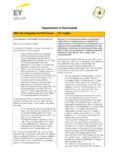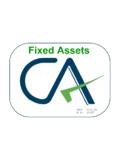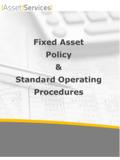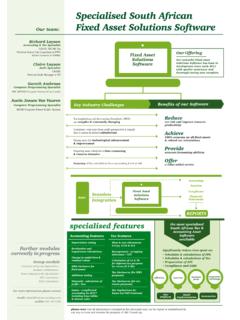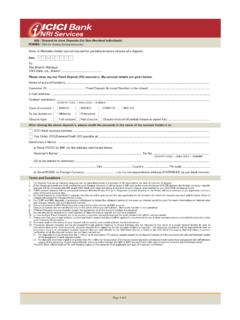Transcription of Asset Revaluation or Impairment: Understanding …
1 COLLABORATE 13 Copyright 2013 by eprentise, LLC Page 1 Asset Revaluation or impairment : Understanding the Accounting for fixed Assets in Release 12 Brian Lewis eprentise Introduction Significant changes in financial reporting requirements have transformed the fixed Asset accounting framework of companies. International Financial Reporting Standards (IFRS) require fixed assets to be initially recorded at cost, but there are two accounting models the cost model and the Revaluation model. So what s the difference, and when should you consider Revaluation versus impairment ? What important changes does R12 bring to fixed assets? IFRS and . GAAP Reporting in Oracle E -Business Suite Although it is clear that the Securities and Exchange Commission (SEC) will not be requiring companies to use IFRS in the near future, most players in the capital markets tend to agree that it is inevitable that IFRS will eventually become a more significant part of the financial reporting environment.
2 This is actually occurring to an extent as more than 400 global companies based outside the are being allowed to file US Securities and Exchange (SEC) financial reports (10K and 10Q generally referred to as annual/quarterly financial reports). For overseas companies who do not file in the with the SEC, IFRS is becoming the world standard for financial reporting. For companies who live in multiple capital markets, there may actually be a dual reporting requirement of both IFRS and GAAP (Generally Accepted Accounting Principles) financial statements. With Release 11i and subsequently with Release 12, Oracle E-Business Suite (EBS) has added functionality to allow users to live in both the IFRS and GAAP worlds.
3 The differences between these two reporting frameworks are extensive; but for the purposes of this white paper, we will focus on fixed assets accounting within EBS specifically Asset Revaluation or impairment . Under GAAP, fixed assets are recorded at historic cost and are then depreciated to a disposal or residual value. If there are certain indicators that the realizable value of the fixed Asset has negatively changed, then the Asset is written down and a loss is recorded. This is referred to as impairment . Under IFRS, financial statement issuers have the option to choose either the cost model (which is in most respects similar to the model) or the Revaluation model (for which there is no parallel reporting under ). Under the Revaluation model, fixed assets may be periodically written up to reflect fair market value something that is specifically prohibited under and SEC authority.
4 The balance of this white paper will focus on fixed Asset Revaluation and impairment under both and IFRS. Prior to diving deeper into this subject, it is useful to run through a list of R12 s new features relating to fixed assets. New and Changed Features in Release 12 for fixed Assets Oracle E-Business Suite (EBS) R12 has a number of valuable new features, many of which were made to fixed assets, including: Subledger Accounting (SLA) architecture Oracle Assets is fully integrated with SLA, allowing for multiple accounting representations for a single transaction or business event. COLLABORATE 13 Copyright 2013 by eprentise, LLC Page 2 Enhanced mass additions for legacy conversions Use the mass additions process to convert data from a previous Asset system.
5 Automatic preparation of mass additions Default rules and public Application Programming Interfaces (APIs) that can be used to complete the preparation of mass addition lines automatically. Flexible reporting using XML Publisher Thirteen customizable new Asset reports. Automatic depreciation rollback Rollback can be executed on select assets as required vs. the entire Asset book, and it is no longer required to be run manually. Enhanced functionality for the energy industry. Retirements and revaluations are now allowed in the period of addition. The many benefits of these additions include process efficiencies, flexible accounting and reporting and industry enhancements. From an acquisition or divestiture perspective, legacy system conversions from disparate standards such as GAAP and IFRS are specifically addressed.
6 So how are GAAP and IFRS the same and where do they differ when addressing fixed assets? Comparing IFRS and GAAP for Business Combinations/ fixed Asset Accounting The table below summarizes and compares GAAP and IFRS requirements for fixed assets after an acquisition. GAAP IFRS Depreciation Same Same Revaluation Prohibited Allowed/Create Revaluation Surplus Depreciation after Revaluation N/A Allowed impairment Direct Write Down Write Down to Revaluation Surplus First, then Direct Write Down GAAP is a conservative rule-based accounting standard that focuses on P & L (profit and loss) financials for use of owners of the entity (shareholders), while IFRS is more of a principle-based accounting standard that focuses on the balance sheet primarily for creditors of the entity.
7 The significant differences in fixed assets between GAAP and IFRS are in the areas of Revaluation , Revaluation surplus and impairment as previously noted, all of which are defined below: Revaluation of fixed Assets Revaluation of a company's assets takes into account inflation or changes in fair value since the assets were purchased or acquired. There must be persuasive evidence to revalue. The change in value is credited to the Revaluation surplus (reserve) account. A downward Revaluation is considered impairment . Revaluation Surplus (Reserve) - The increase in value of fixed assets due to the Revaluation of the fixed assets is credited to Revaluation surplus (reserve). impairment of fixed Assets impairment of a fixed Asset occurs when the realizable value of an Asset , as shown in the balance sheet, exceeds its actual value (fair value) to the company.
8 When impairment occurs, the business must decrease its value in the balance sheet and recognize a loss in the income statement. COLLABORATE 13 Copyright 2013 by eprentise, LLC Page 3 Cost Model vs. Revaluation Model for fixed Assets Cost Model In the cost model, the fixed assets are carried at their historical cost less accumulated depreciation and accumulated impairment losses. There is no Revaluation or upward adjustment to value due to changing circumstances. This is similar to the model currently in use by GAAP. Example Acme Ltd. purchased a building worth $200,000 on January 1, 2008. It records the building using the following journal entry: Building 200,000 Cash 200,000 The building has a useful life of 20 years, and in this example the company uses straight line depreciation.
9 Yearly depreciation is $200,000/20 years, or $10,000. Accumulated depreciation as of December 31, 2010, is $10,000*3 or $30,000, and the carrying amount is $200,000 minus $30,000, which equals $170,000. We see that the building remains at its historical cost and is periodically depreciated with no other upward adjustment to value. If an Asset is subsequently valued down due to impairment , the loss is charged to the income statement as impairment loss. Revaluation Model In the Revaluation model, an Asset is initially recorded at cost, but subsequently its carrying amount may be increased to account for appreciation in value. The difference between the cost model and Revaluation model is that the Revaluation model allows both downward and upward adjustment in value of an Asset , while the cost model allows only downward adjustment due to impairment loss.
10 This is the model currently adopted by IFRS. Example Consider the example of Acme Ltd. used in the cost model. Assume that on December 31, 2010, the company intends to switch to a Revaluation model and carries out a Revaluation exercise which estimates the fair value of the building to be $190,000 (again, at December 31, 2010). The carrying amount at the date is $170,000 and revalued amount is $190,000, so an upward adjustment of $20,000 is required for the building account. It is recorded through the following journal entry: Building 20,000 Revaluation Surplus 20,000 Revaluation Surplus Upward Revaluation is not considered a normal gain and is not recorded on the income statement; rather it is directly credited to an equity account called Revaluation surplus.


